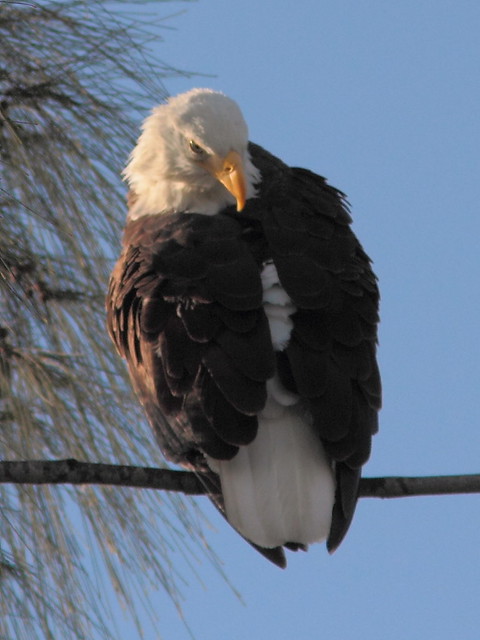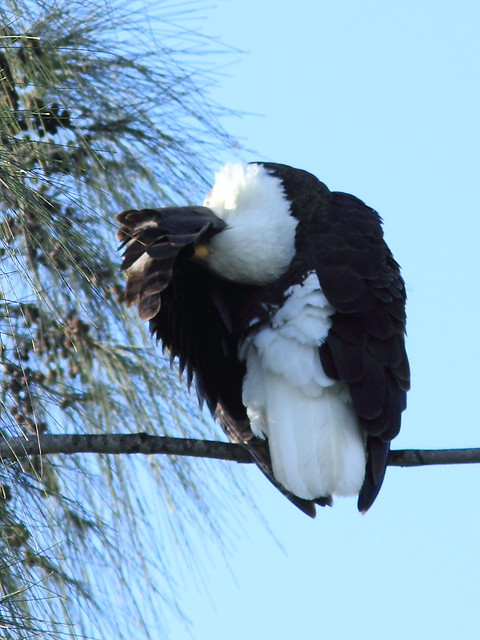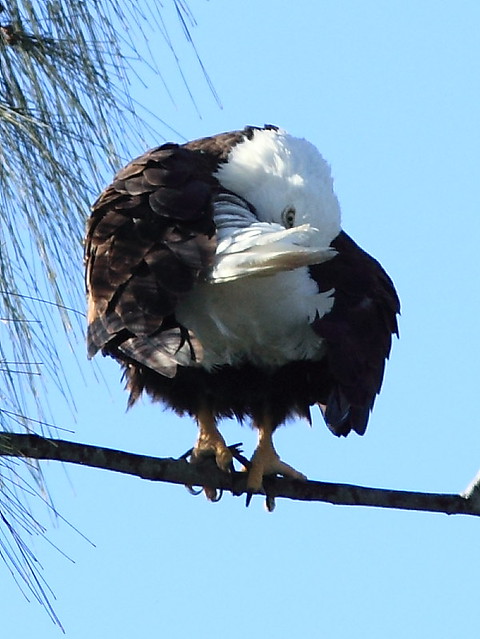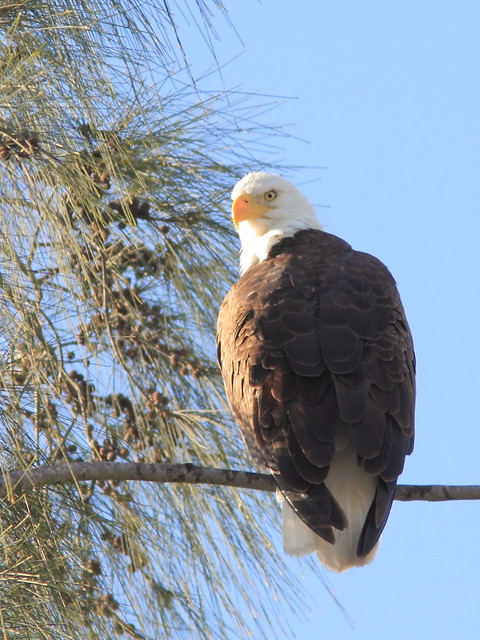In late December, 2007 I observed a pair of Bald Eagles courting on the roof of a house across the lake from us. I had just acquired a first generation Canon Digital Rebel, my first DSLR camera, a gift from our son-in-law after he had upgraded to a Canon 30D. The eagles were about 175 yards away. Hand held and without image stabilization, my heavily cropped images were fuzzy, but I captured the action.
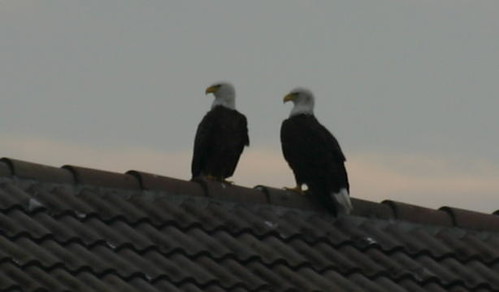
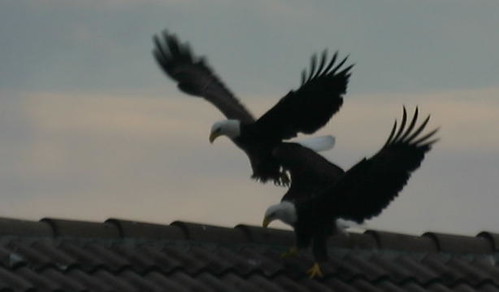
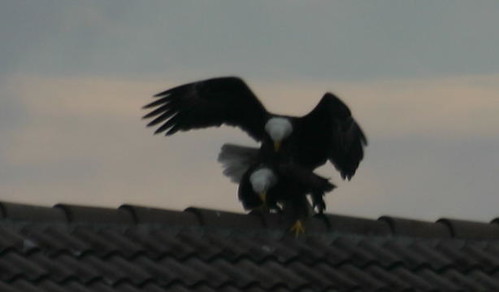
This led to a search and "discovery" of their nest in March, 2008, in the neighboring City of Pembroke Pines. It was in a roadside Australian Pine about 2 miles northwest of our home. It contained a single eaglet. Subsequently, they have returned to the same nest each year. With a group of local residents, I have tracked their breeding successes and failures, and recorded behavioral observations on a spreadsheet. Over the past 5 seasons they have produced 9 eaglets, and all but one fledged successfully.
Here, two of our granddaughters are shown viewing the nest in 2009.
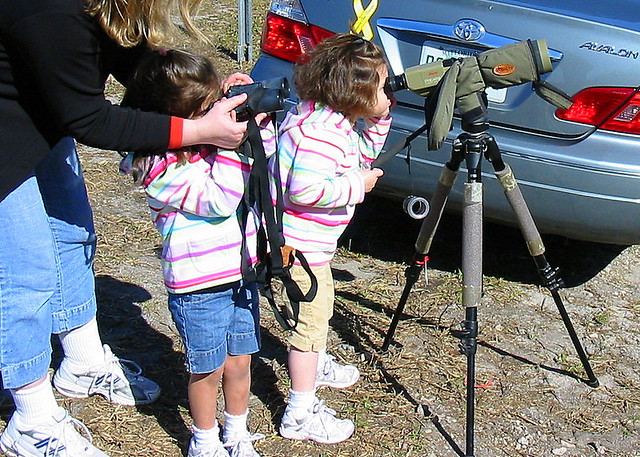
The 2009-10 season was a spectacular success, with three eaglets. Local middle school students studied their progress. They selected several "candidate" names, and on an internet poll held an "election" that resulted in them being named (in hatch order) "Lucky," "Chance" and "Courage."
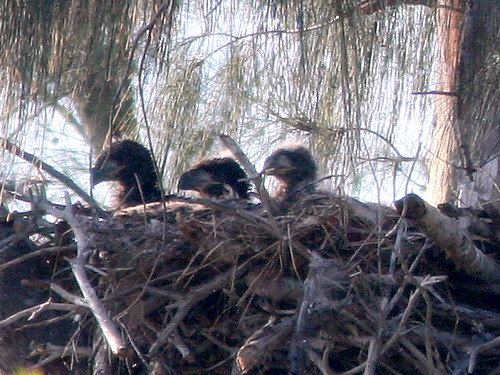
Sadly, their single chick that hatched last season disappeared just a few days before it would have been old enough to fly freely. This blog entry describes how we searched for it without success. Here is "P. Piney Nine" in happier days.
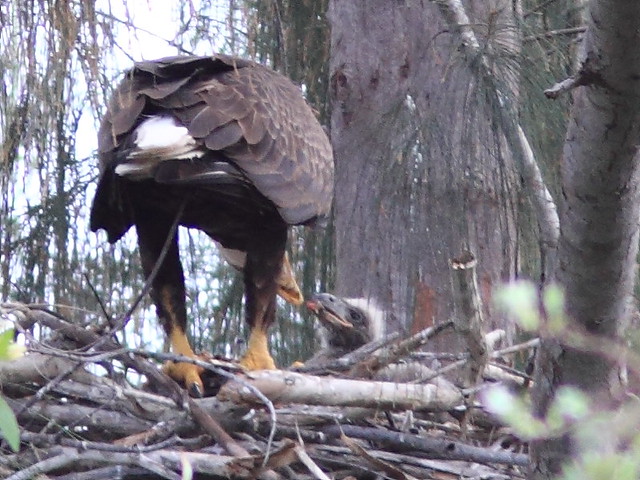
This season, the pair returned to the nest in late September and began refurbishing the nest. Based upon our ground observations, their first egg was laid on or about November 27. With an expected incubation period of 35 days, it should hatch around New Year's Day, 2013. Visit this link to view a chart that summarizes the milestones for each of the past 5 breeding season, and a FORUM where volunteers post their observations .

Mary Lou and I regularly stop by the nest just to check on the welfare of the eagles. During incubation, about the only interesting thing that might happen would be an exchange of incubation duties. The female usually sits on the eggs all night, with the male roosting nearby. He then flies out to forage shortly after sunrise and returns to the nest area a couple of hours later. We arrived at the eagle nest just before 9:00 AM on the morning of December 21. It was a cool 65 (F) and there was a steady wind in from the north, behind me. The female was incubating deep in the nest, the top of her head barely visible.

Only about a minute later she started calling and the male flew in from behind the nest area and took a roost in a tree a short distance to the west (right) of the nest.
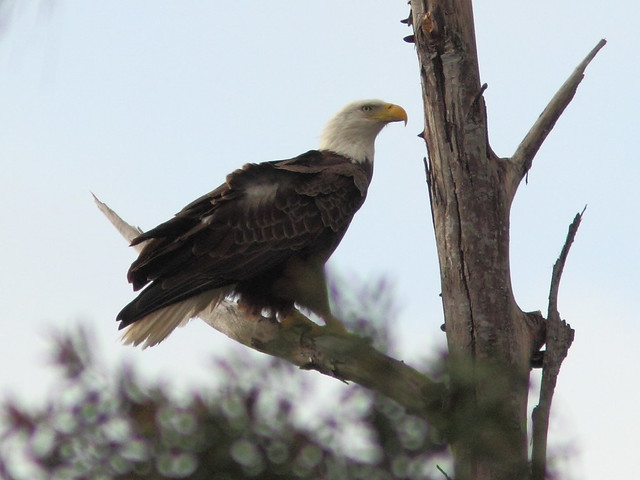
They called to each other for a moment, then the male launched up and into the wind, passing in front of the nest, disappeared briefly behind the nest, then landed on the nest into the wind.


The pair exchanged incubation duties, and the female promptly flew into the Melalaeuca snags to the west of the nest area.

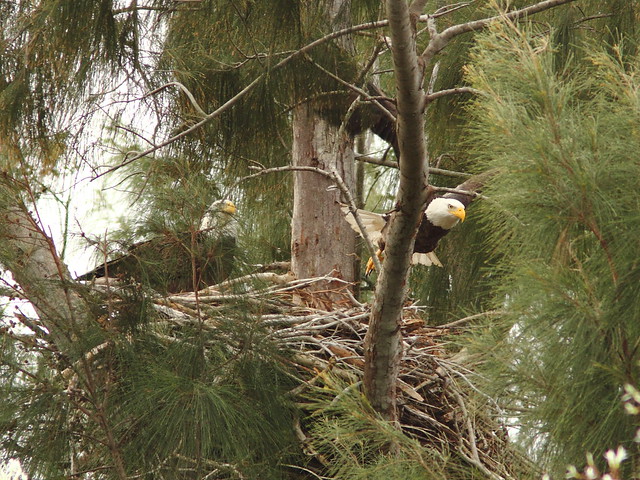
There, she preened for a while and was still there when we departed about 20 minutes later.
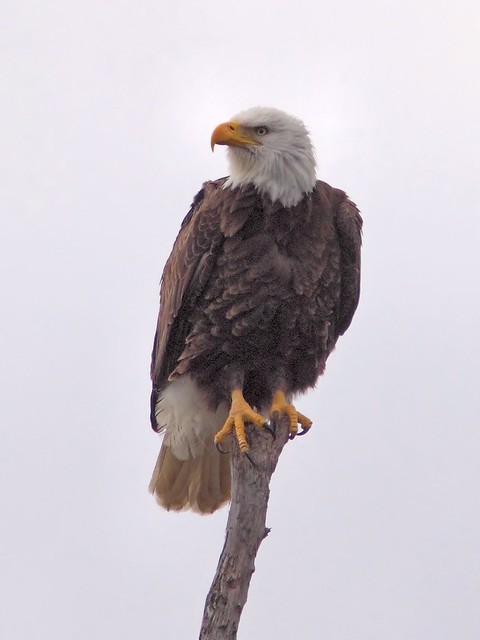
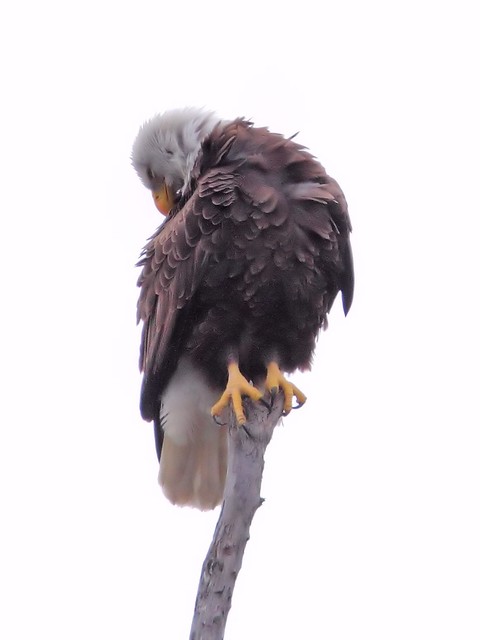
The male is noticeabley smaller and slimmer, and his forehead is almost in line with the ridge (culmen) of his bill.

The female has more of an angle between the culmen and her forehead.

We are hoping that the eagles enjoy a happy and successful New Year, and we wish the same to all of you!
In October, 2005, just a little over a year after we moved to south Florida, Hurricane Wilma hit us directly. Although we went without power for a few days, lost a couple of trees and had minor roof damage, we were relatively unscathed. Several days later, we visited the wetland patch near our home. This is actually a wetlands preserve set aside by developers to mitigate some of the loss of original Everglades land-- the West Broward Water Conservation Area.
We found that many of the old dead trees that had served as roosts for larger birds such as raptors and herons had been knocked down.
This was one of the few relicts. I called it the "stork tree." It finally toppled in 2010.
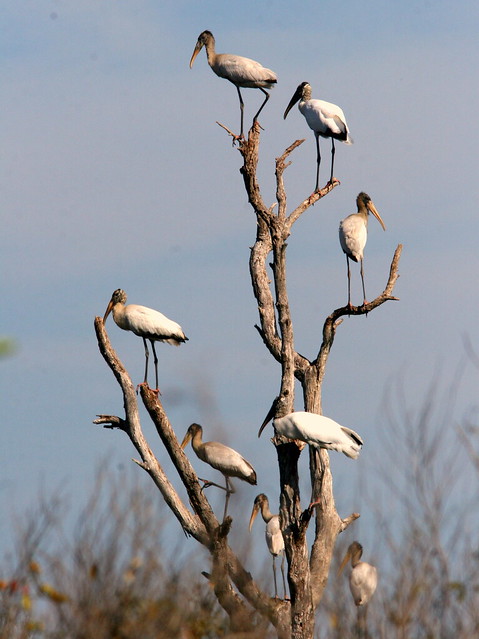
One snag felled by Wilma took down a power pole from an abandoned line that crossed into the wetlands, and wires draped across our path. The power company removed most of the wires but left a single one that sagged down to about 15 feet over the path but was not obstructing access.
The favored perches were rather distant, so my photos are generally of poor quality. This is the second pole out from the path. A Red-shouldered Hawk is barely recognizable on the third, and Common Grackles occupy the nearer pole.
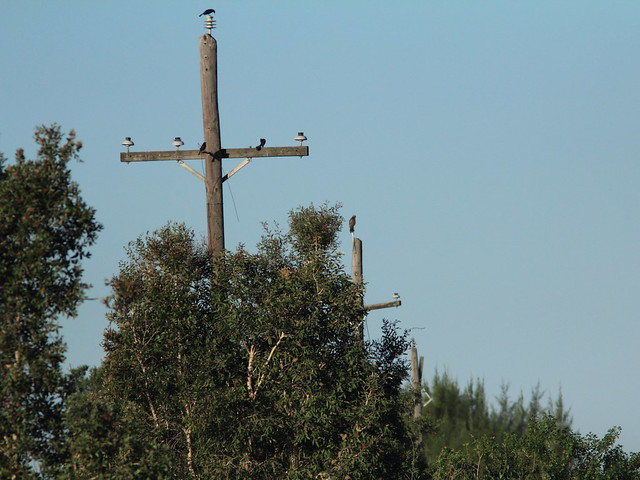
Without the old trees, the power poles became especially attractive to Ospreys that nested in a grove of exotic Melaleuca trees at the far northern extent of the preserve. Here, a Belted Kingfisher looks down at an Osprey on the pole nearest to the path.

Over the past seven years the wire provided a perch for quite a variety of birds. I recently took this photo of an unlikely association between an American Kestrel and a Loggerhead Shrike, not knowing that the wire would be taken down the next day.
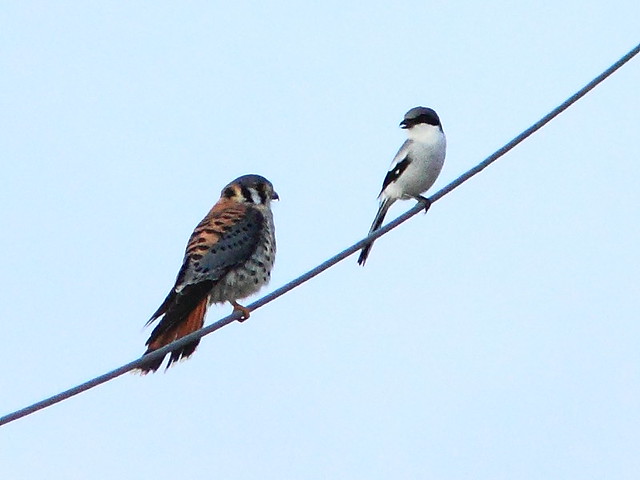
A year ago I caught them sitting almost shoulder-to-shoulder!
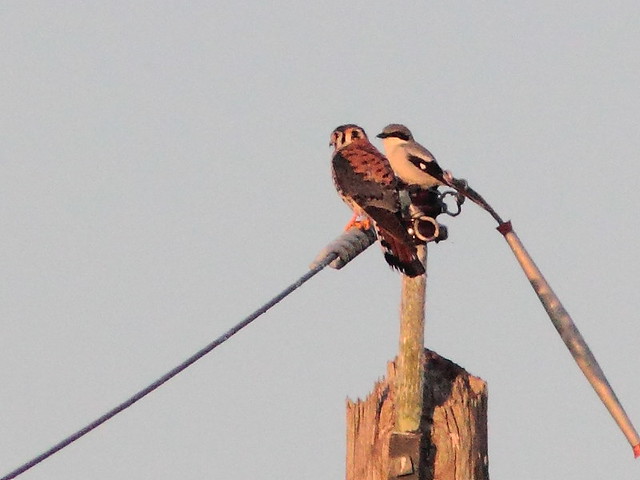
A pair of Northern Flickers also shared the wire with a kestrel.
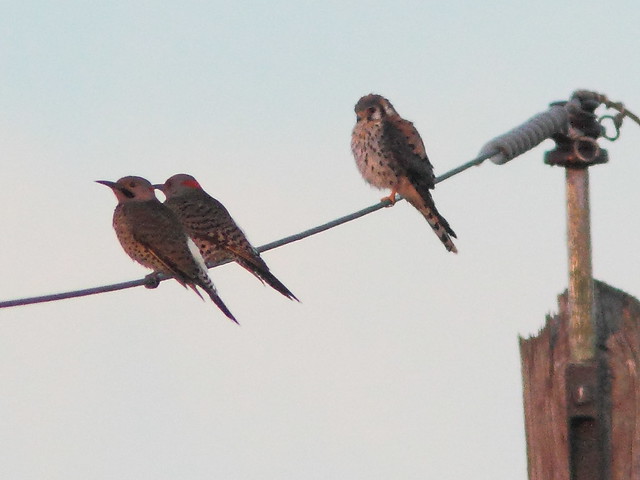
Once there was an odd gathering of a kestrel, a kingfisher and two shrikes.

Red-winged Blackbirds liked to sing from the wire.
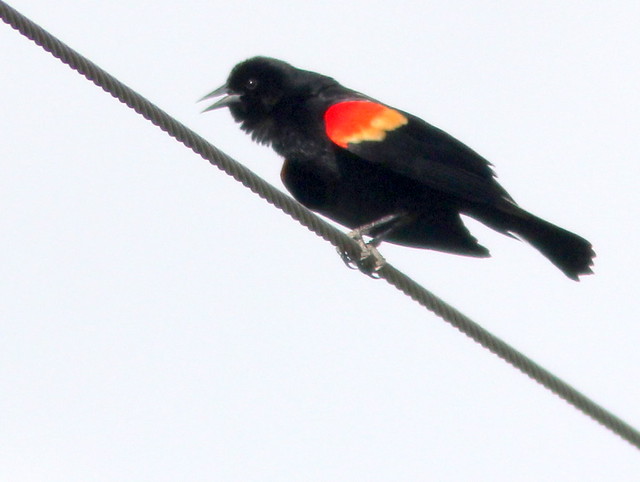
For a little variety, a blackbird was joined by a Northern Mockingbird, a female flicker and a male kingfisher.
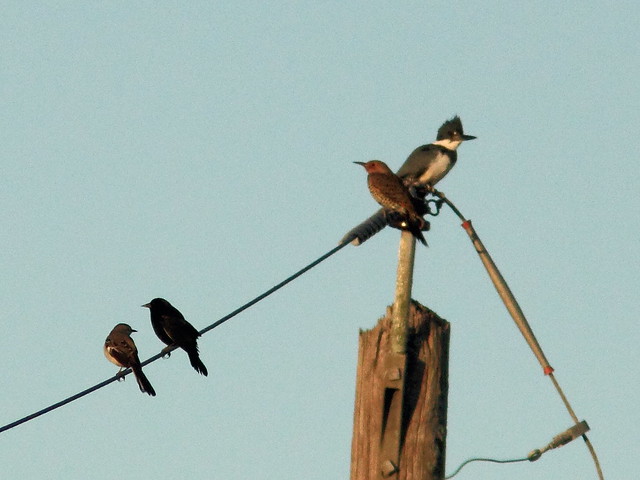
A male flicker joined this shrike.
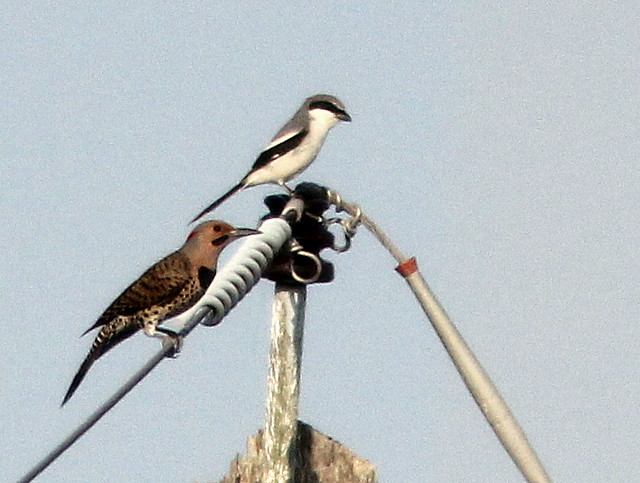
A pair of Red-tailed Hawks conducted their courtship on the pole.
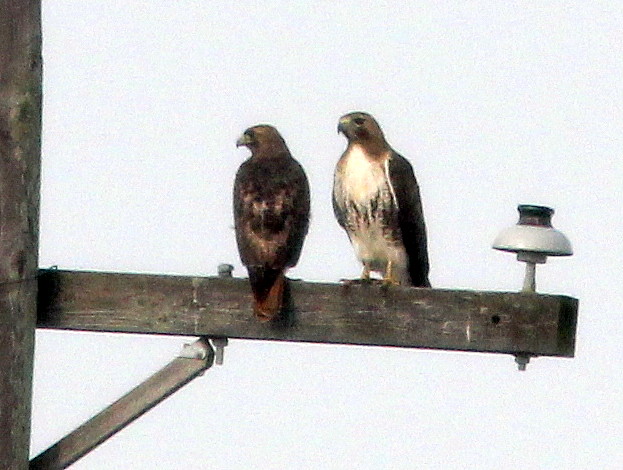
Doves were well-represented, including this Mourning Dove...
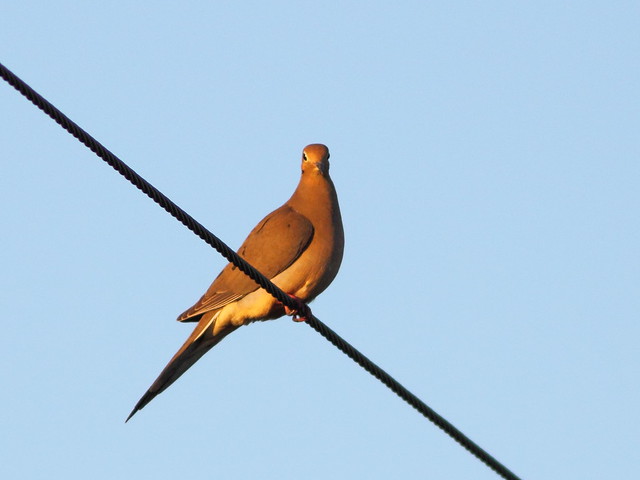
...a Common Ground-Dove...

...and a White-winged Dove.

An unusual occupant was this Common Nighthawk. They usually do not perch crosswise, and prefer a tree limb to a wire.
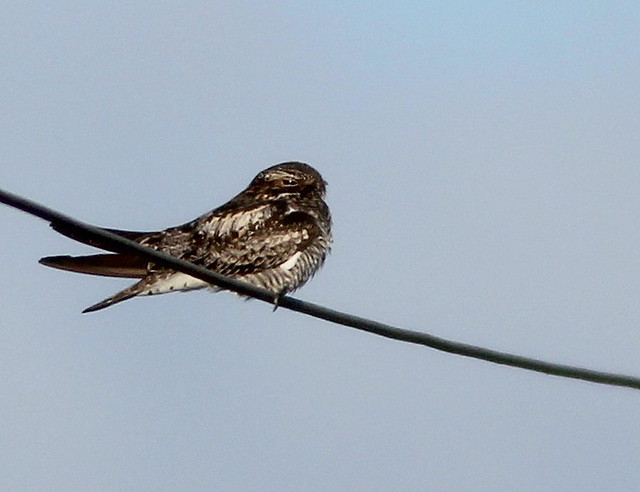
A bald Eagle passed by closely but did not stop.
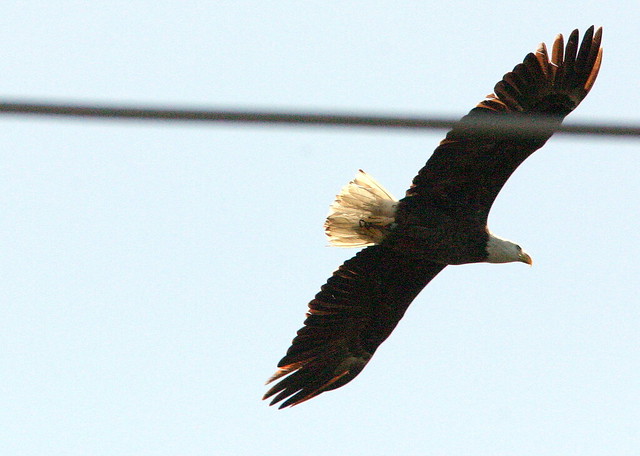
All in all, I have tallied a total of over 20 species on the wire and adjacent poles. Other species that I have seen on the wire have been Eurasian Collared-Doves, Boat-tailed Grackles, Starlings, Fish Crows, a Northern Cardinal, Monk Parakeets, and of course, Blue Jays.
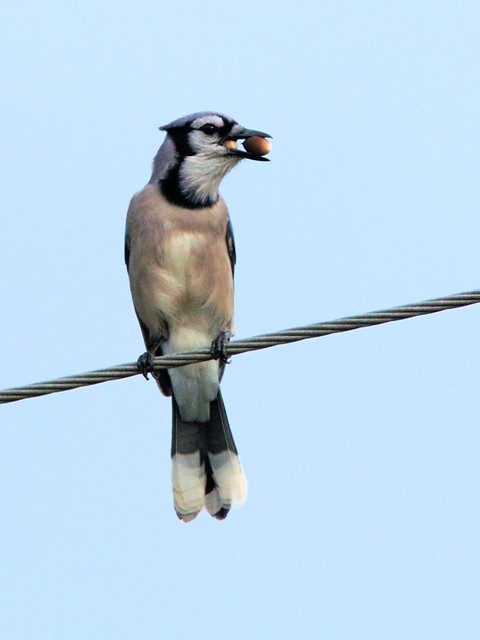
The power company had no choice but to remove the inactive wire, as the pole that supported its other end had to be removed and replaced by a new and taller one. Now the wire rests under the pole, neatly stowed and carrying only memories the many birds that swayed with it in the wind.

Now my concern turns to the fate of the old poles that course into the wetlands. Two years ago, Ospreys nested in this Meleleuca grove across the wet prairie, but this spring it was treated with herbicides and every tree was killed. Their ghosts now line the northern boundary of the preserve, eventually to be cut and removed for a highway right-of way.

I never found the actual nest (the only access is over private land), but saw the Ospreys bringing prey into an area about one third of the way down from the far end of the grove of now defoliated and dead trees. Might it be possible for the "powers that be" to allow the old telephone poles to stand, and serve as hosts for one or more Osprey nest platforms? I fear that I am assigning myself another mission.
We had to go to the Post Office one morning this past week, so it gave us the excuse to get out early and visit a couple of birding spots along the way. It rained very hard, but only briefly just after sunrise, and a double rainbow appeared as the skies cleared.

Our first stop was Chapel Trail Nature Preserve in Pembroke Pines, the next city north of us. As we pulled into the parking area we saw some birds gathered around a rainwater puddle.
Several Common Grackles were enjoying their baths.
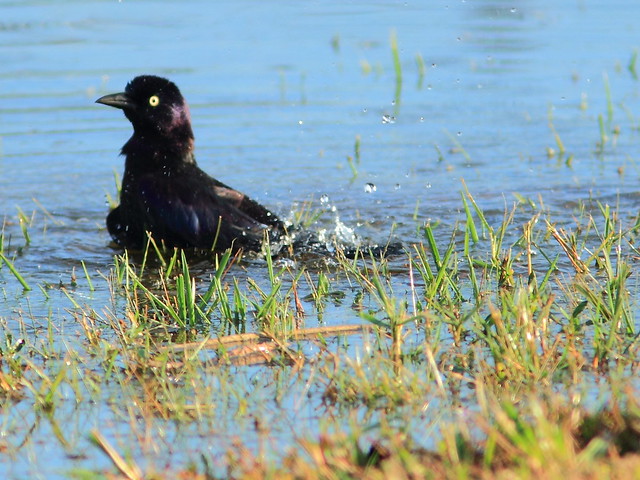

A White Ibis foraged among them. Since this is just a temporary body of water, I assume their prey to be insects and other invertebrates that were flooded out from the grass and underground.

Killdeers probed the perimeter of the puddle.

A lone male Mottled Duck dabbled in the puddle.

We set out on the boardwalk, which traverses a small wooded area, a couple of creeks or sloughs (some call them "slews") and a wet prairie containing several small lakes.
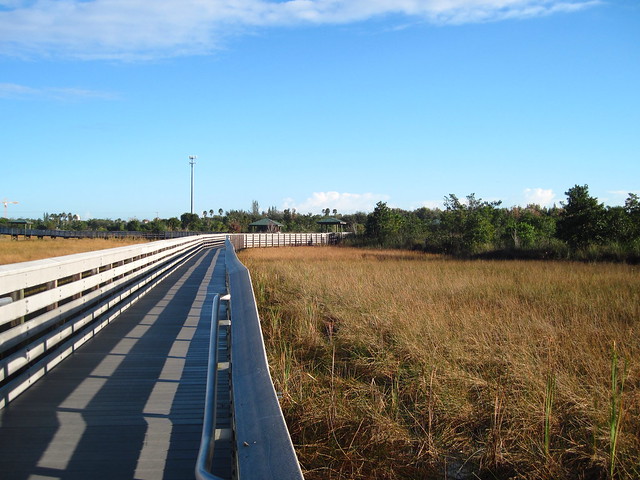

A soft-shell Turtle surfaced beneath the boardwalk, only its nose and eyes above the water.

Three Wood Storks seemed to ignore our presence.

A Northern Mockingbird perched nicely in great light.
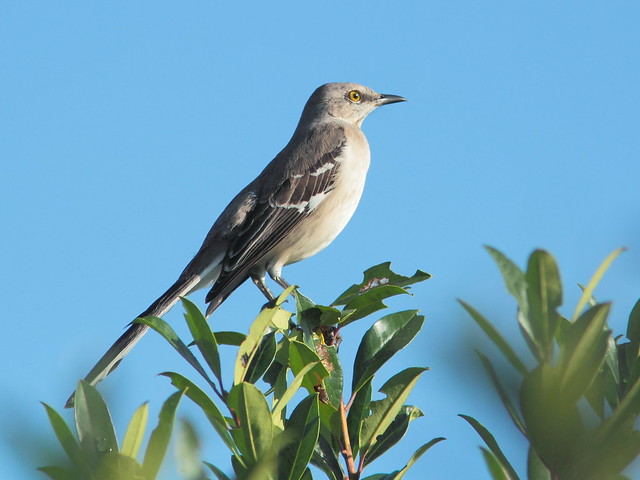
I was surprised to hear the call of an American Robin. It was rather far away on the top of a tall Melaleuca, which was in bloom. We see relatively few robins. Some years they never appear in our neighborhood, and when they do they are usually in large flocks. This one was alone, the first seen this winter.

As usual, Mary Lou got ahead of me on the boardwalk. She called my cell to say she had spotted a hawk perched on the boardwalk ahead of her. I hurried to get a look. At first I thought it was an immature Red-shouldered Hawk, which is a relatively common resident. Upon closer examination, I noted that its legs were shorter than those of a Red-shouldered, and its tail, instead of showing many narrow bands, had only a few wide ones. I thought it was a Broad-winged Hawk. But wait-- its body is long and cylindrical, and tail too long for a Buteo. It's an accipiter, an immature Cooper's Hawk.
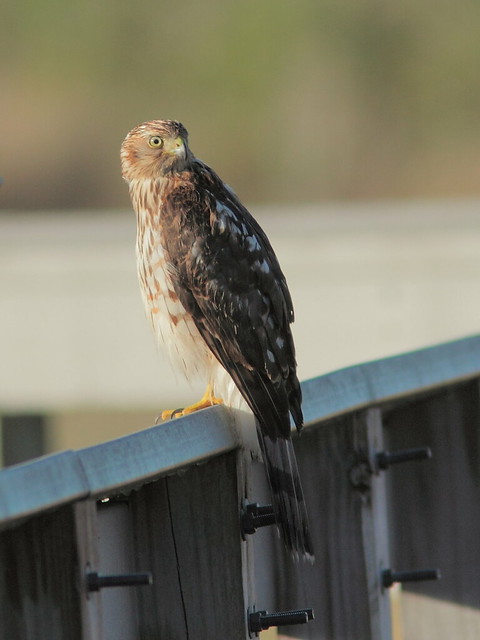
Later, an adult Cooper's Hawk flew overhead. Its big head, larger overall size, and rounded tail distinguish it from theSharp-shinned Hawk.
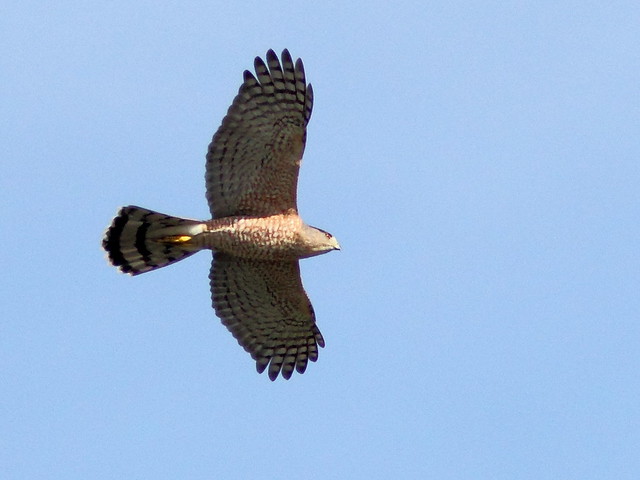
Several exotic and invasive Purple Swamphens were much in evidence. These birds were introduced near this location in the late 1990s, and have proliferated and extended their range northward despite a vigorous but futile program to exterminate them. In addition to a staple diet of roots and stems of water plants, they prey on the eggs and young of marsh birds. Since we arrived in 2004 we have seen fewer native gallinules at Chapel Trail -- in fact, not a single Purple Gallinule in more than three years.
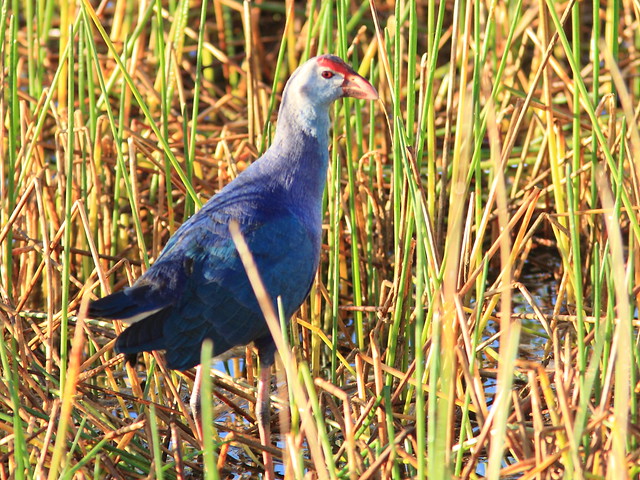

We had visited a few days earlier, just after arriving home from Illinois. Our target bird that day was a Florida specialty, one of our favorites, the Limpkin. We were not disappointed.
As we reached the far end of the boardwalk, a Limpkin flew in front of us and settled in the wet prairie.
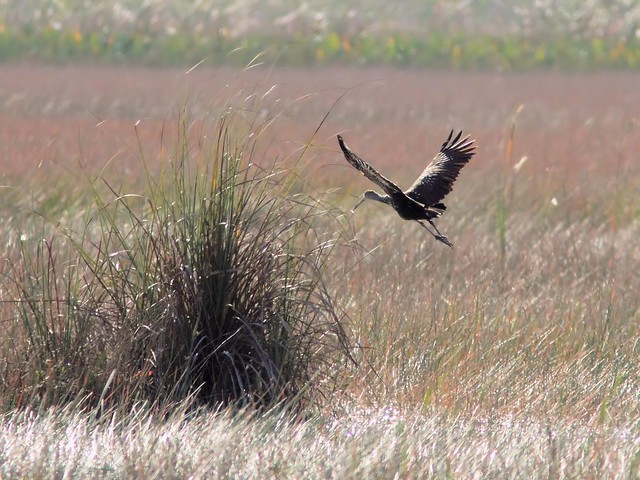
It was nearly hidden by the grass and sedges.
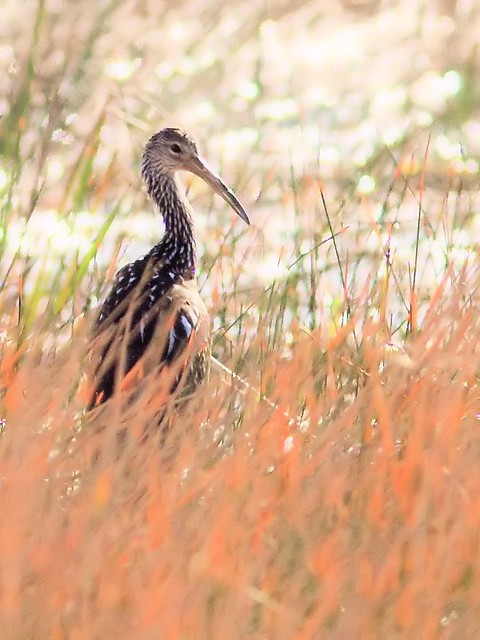
We thought that would be about our best view of the Limpkin, but it surprised us by flying up again and settling in a small tree.
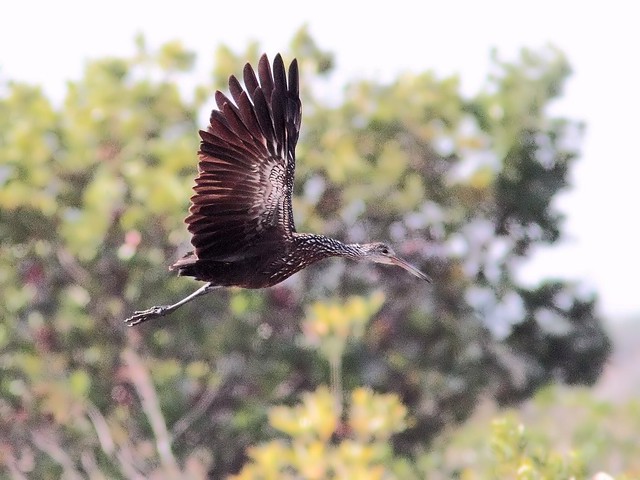
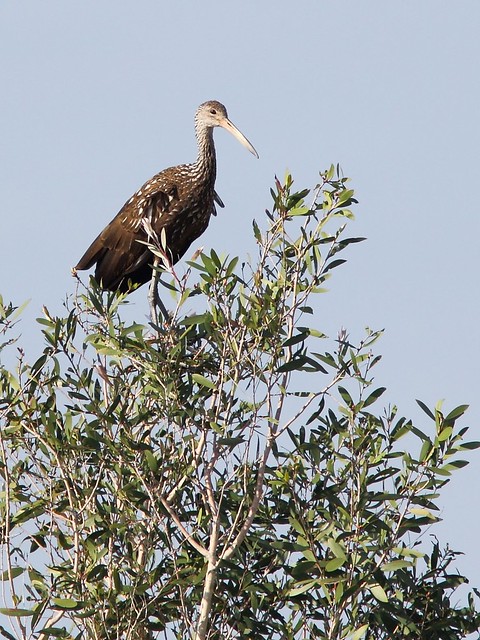
After posing for a moment, it flew towards us and right over my head. The nearest photos did not turn out well, as I had trouble keeping the bird in the camera viewfinder, so I stitched the ones I salvaged into this time-lapse sequence. (Click on the image to view it larger on black.)

Before going on the the post office, we stopped a couple of blocks away to check on the welfare of the local Bald Eagles. Their eggs were laid near the end of November and should hatch around New Years Day. We found one adult on the nest, fluffing its feathers, but it immediately settled down to incubate and was almost out of sight. Only the top of its head and tail were visible. Follow the ground observations and photos submitted by eagle watchers on my Pembroke Pines Bald Eagle nest monitoring FORUM.

Its mate (which, from her bulky look and high forehead, appears to be the female) was roosting in a tree adjacent to the nest tree. She was fluffing and preening, leading me to believe that the pair may have just finished exchanging incubation duties.
